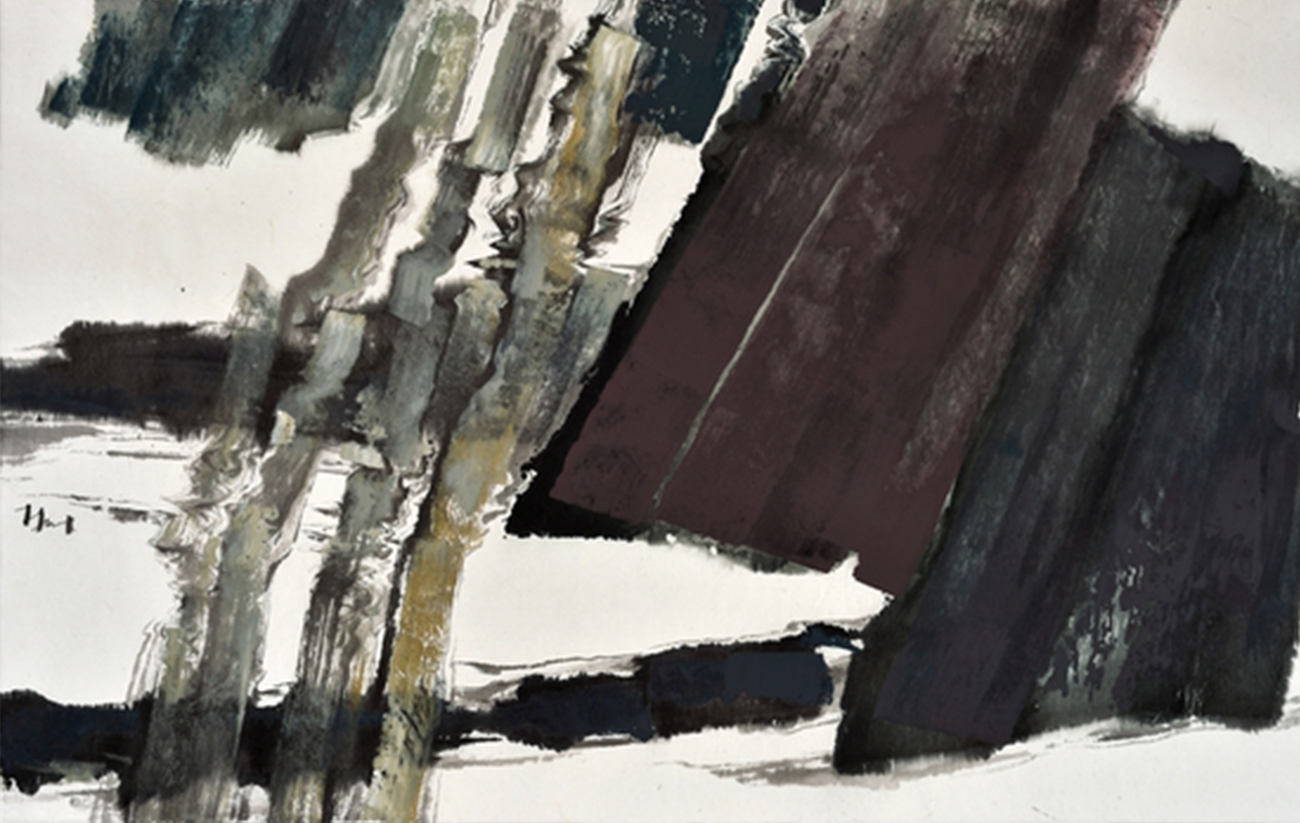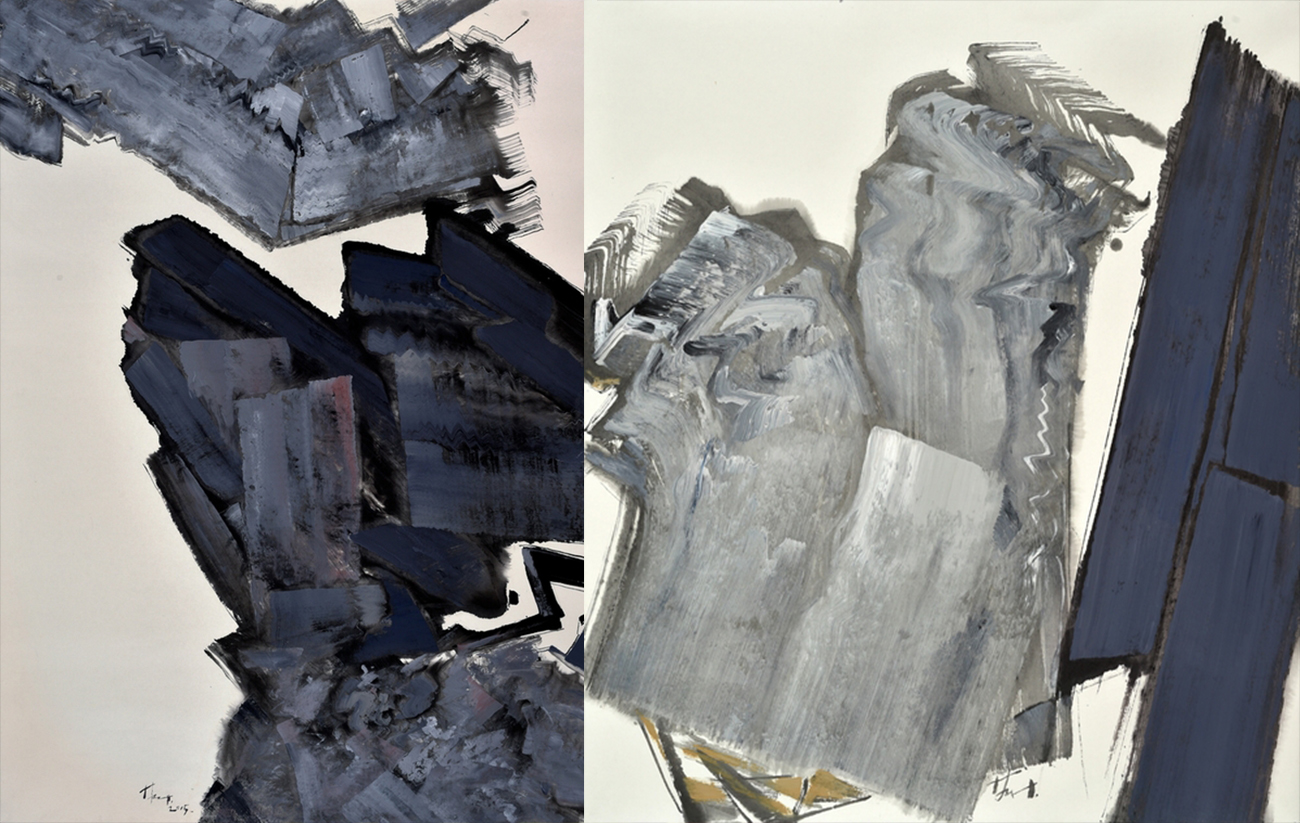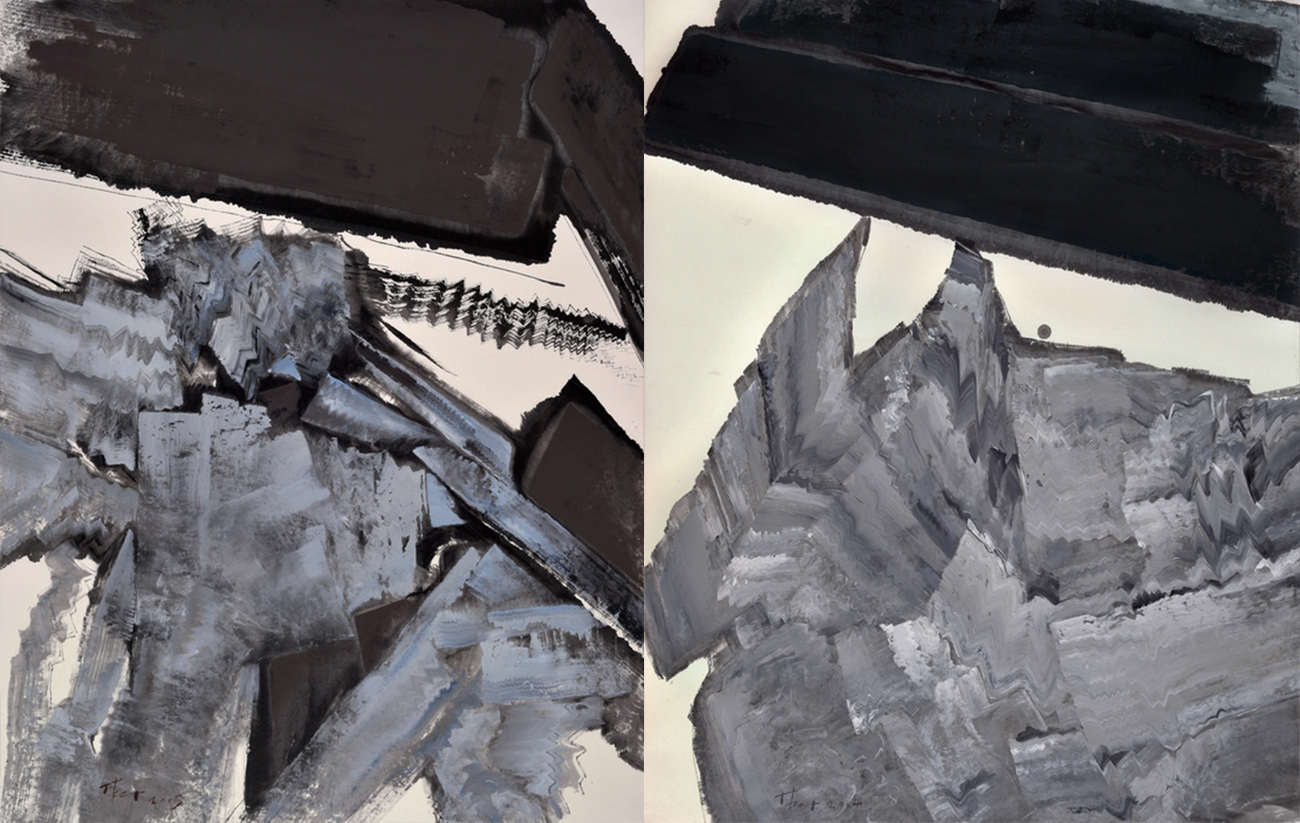再见师造化 ——林学明《触山》系列观后

近日在网上看到陈颖编译萨尔兹(Jerry Saltz)的一篇短文《为什么新抽象主义作品看起来如此类似》,文中附了六组图片,每组5至6件作品,作品均有出处,互相比较,的确雷同严重。文章将此归因于投合市场。
Recently I came across one short article online titled "Why Are Neo-abstract Expressionist Works Look So Much Alike?", which was written by Jerry Saltz and edited by Chen Ying. In the article six groups of images were attached, each containing 5 to 6 pieces of art works with provenances. One could easily detect a serious resemblance or similarity between the pieces and, according to the article, the market-oriented mentality is to blame for it.
就我二十余年的批评经历看,问题并不那么简单,不少艺术家在未成名时带着强烈的反世俗、反成规,不顾贫穷和环境压力关门作画,面世后却不期然与别人撞车,此类现象在抽象艺术中尤其多见。其根源就在抽象艺术自身。
Nevertheless, my experience as an art critic over the past twenty years tells me the problem is not as simple as it appears. Quite a number of unknown artists were totally engaged in their art creations behind closed doors, despite their poverty and depressive living conditions, with a strong sense of anti-social norms and established rules .Yet their finished works, once shown to the public, may accidentally bear a resemblance or similarity to those already created by other artists. Such a phenomenon is especially true in the genre of abstract art, due to the nature of abstract art itself.
从纯艺术穿透到反艺术,其时空隧道是没有厚度的“零”,杜尚称为“致虚薄”,丰塔衲画布上一刀捅破了窗户纸,使纯粹化的极限瞬间转为反艺术的弧光。抽象艺术比较靠近“零”点,因此谱系较窄。与光谱类似,纯粹的谱系无限窄于混杂的谱系。当康定斯基推行他的《点·线·面》理论之后,“画布上的创造”,“纯造型的世界”便成了抽象艺术家的口头禅,但没走几步,人们突然发现:好像已经没路了。马列维奇的纯黑方块,克莱因的纯蓝画布,雷曼的白色画布,桑德、纽曼、里希特的单纯红色,彼此之间到底是异还是同?后来者对先行者到底是模仿还是独创?看来,怎么回答都是陷阱。
From pure art to anti-art, the physical scope is “zero” without any gap, which, according to Marcel Duchamp, is called “Infra- Mince”. The moment when Lucio Fontana cut open his canvas, he turns the pure limit space into an anti-art arc light. The abstract art lays very close to the “zero” point, with a relatively narrow scope . Similar to the spectra - the scope of pure spectrum is infinitely narrower than that of the mixed one. Following the introduction of the theory "Point-Line-Surface" by Kandinsky, the so-called "creation on the canvas" and "creative world " have become the pet phrases of the abstract artists. Nevertheless, it did not last long since people started to realize that they could go nowhere with them. In the cases of Kazimir Malevich's pure black blocks, Klein's pure blue canvas, Lehman’s white canvas, Sander, Newman and Richter’s pure red color, are they different or similar anyway? Are the predecessors imitating their pioneers, or simply creating their own? There seem no correct answers to this question at all.
林学明既然迈入抽象绘画,必然要面对如何摆脱雷同的困境。
目前说林学明大功告成还为时尚早,重要的是他避免了雷同。无论是始于2008年的书写系列还是始于2012年的排笔系列,个性都很清晰,都形成了自己的创作脉络。究其因,是他摆脱了画布上的关门创作,摆脱了仅在点线面之中苦思冥想,转而面向生活,让一千多年前唐人张璪“外师造化,中得心源”的理念在抽象艺术中重新复活。只是对于今日的艺术家而言,造化指一切生灭演化的视觉对象,包括自然界以及人类社会的物质产品和精神产品。从这个意义上说,师造化而得心源正是多数成功的抽象艺术大家的共同经验。摩尔在拜石中独得心源,米罗在有机世界中独得心源,德·库宁在女人体面前独得心源,波洛克则在师法新的媒介物质时独得心源……

Having touched on abstract arts, Sherman Lin has to deal with this dilemma of avoiding resemblance or similarity.
It may be too early to conclude that Sherman Lin has already achieved major success, yet it is his success in jumping out of that trap of resemblance or similarity that counts. Whether in his Calligraphic Painting Series starting from 2008 or in his Broad Brush Painting Series starting from 2012, he has achieved his own distinctiveness and formed his own creativity traits. Coming out from the closed door, Sherman frees himself from the painful study of “Point-Line-Surface” and turns to real life, re-living the principle of "Being inspired by the external universe, while remaining loyal to one’s internal world" by Zhang Zao, a traditional Chinese artist in Tang dynasty over a thousand years ago. In the eyes of the contemporary artists, nature consists of all visual objects, dead or alive, remaining or evolving, which include nature itself, the material products as well as the spiritual world of the human society. It is in this sense that “Turning to nature for artistic inspiration” has been the experience shared by many successful abstract art masters, such as Henry Spencer Moore, who was inspired by the stones, Joan Miró, motivated by the organic world, Willem De Kooning stimulated by female’s figures and both Pierre Soulages and Jackson Pollock who were encouraged by the new media.
林学明呢?他在师法人化自然、人造产品中独得心源。当然,这只是个粗略的说法,他同时也在师法原自然。
As for Sherman, he is inspired both by nature as well as by artifacts. Of course, this is just a general conclusion, as he is at the same time learning from the pure nature as well.
林学明是位设计师,但他明确反对将设计直接变为抽象绘画,他强调的是生活与心灵的独特感应,只是因为设计是他生活和生命存在的基本方式,生活与心灵的感应便不可避免地却又是自然而然地带上了设计的烙印和遗韵。

Being a designer himself, Sherman is unequivocally against the direct transformation from designed works to abstract arts. What he focuses on is a unique merging point between secularity and spirituality. Designing being the fundamental part of his life and living, this merging point between secularity and spirituality inevitably and naturally bears the traits and charms of designing.
林学明是如何发现生活与心灵的独特触点的?以不拘泥于排笔的排笔系列为例,有几点十分重要:
How does Sherman discover this unique merging point between secularity and spirituality? We can find several significant clues from his Broad Brush Painting Series which are not restricted to the broad brushes alone:
1、 改变观察方式。与传统的观察方式和取景习惯不同,林学明十分擅长超常规地局部观察和微观取景,为此他积累了丰富的图像资料。他因擅长这种观察方式而陶醉其中,因陶醉其中而有所发现,因有所发现而趋向了抽象,因经常面对设计产品而悟得了独特的几何构成和排笔结构,进而又在人化自然和原自然的关联中发现了几何抽象和抒情抽象、方直排笔和流纹排笔的互补结构。在他作品中,整体的几何构成和排笔并不完全重合,而是时分时合的两个方面。他有时直接以排笔绘出几何构成,画面结构即排笔结构,这类作品在前些年较多;有时则用方直排笔和流纹排笔反复交错反复叠加的方式绘出整体的几何构成,排笔结构只是画面结构的组成元素,近来这类作品越来越多。从发展趋势看,后一种方式更有潜力。使用排笔的艺术家并不少见,林学明创造了自己的阴阳、刚柔、虚实、动静、情理、寒热相克相生的语言结构和精神结构,从而独立于排笔之群。
1. Methods of observation: His unique ways of observation, Different from the conventional ways of view finding, Sherman is exceptionally skillful in his unconventional partial observation and micro-view finding. For this purpose he has accumulated a huge reservoir of image collections . Totally carried away by this unique way of observation, he has been rewarded with new findings which evolve to abstract expressionism. His frequent involvement in product designs has inspired him to the creation of his unique Broad Brush Painting Structure, and the discovery of the mutually supplementary structures between Geometric Abstractionism and Lyric Abstractionism, Square and Straight Broad Brush Strokes and Flow Line Broad Brush Strokes, based on his understanding of the correlation between humanized nature and the pure nature. In his works, the overall geometric compositions do not overlap completely with his broad brush. Rather, they are two sides of the same coin. Sometimes, he makes the geometric compositions with broad brush, which turns the whole picture into a broad brush structure(such a technique was more frequently seen in his earlier works); other times he alternates between square and straight broad brush strokes and flow line broad brush strokes or overlaps the two to create his overall geometric compositions, while broad brush structure simply serves as one component of the overall picture(such technique has been applied more often in his recent works). From a future development perspective, the latter promises greater potentials. There are many artists who use broad brushes, yet it is Sherman who has stood out among his peers by creating his unique artistic language structure and frame of mind, consisting of contradictory yet harmonious elements such as Ying and Yang, firmness and flexibility, reality and fancy, movement and motionlessness, sense and sensibility, and coldness and warmth.
2、 改变写生方式。在古典艺术中,中国与欧洲的写生方式差异巨大,欧洲是镜象式写生,中国传统绘画一直采取的却是应象式写生。所谓应象式,就是用一套笔墨规范和造型程式应对自然,程式使自然转化为具有绘画程式的自然,写生又使程式不断获得鲜活的生机。西方自塞尚提出“第二自然”之后,应象式写生逐渐取代了镜象式写生的主流地位,它与中国传统应象式写生的最大不同在于艺术观念的现代性,这突出表现为以个体程式的创造取代集体程式的运用。林学明的写生方式便是在现代性的意义上,既逆反于西方古典又逆反于中国传统的写生方式。林学明在草创了自己的语言结构和精神结构之后,便以一种个人化的新的视觉结构应对物象,以个体程式对景写生,近两年黄山、太行山、秘鲁利马、加拿大洛矶山的写生便是如此,正如他自己所说:“有时我把自然中的微观,看成是一件器物,把恢宏的太行山脉看作是屏风或是器形”。
2. His unique ways of live painting. There was a significant difference between the Chinese way of live painting and the European way in classical arts. The European way is called “Mirror Image Method”, while the Chinese traditional painting had applied the method of “Responsive Image Method”, which adopted a series of painting rules and image formats that reflected the nature. These formats transformed nature into certain paintable formats which had been constantly rejuvenated and revived through live painting. Ever since the introduction of Paul Cézanne’s “the Second Nature”, the “Responsive Image Method” has gradually replaced the predominating place of “Mirror Image Method” which differs significantly from the traditional Chinese one in terms of the contemporary nature of its artistic concepts, highlighted by the creation of individual formats instead of the application of collective ones. Sherman’s methods of live painting, in a contemporary sense, differ from either the western classics or the traditional Chinese way. After forming his own broad brush painting structure and his frame of mind, Sherman responds to the nature with a brand-new, unique and personalized visual structure and conducts his live paintings with an individual format, which was best exemplified in his live works series on Yellow Mountain,Taihang Mountain, Lima of Peru, and Rocky Mountain of Canada over the last two years. To quote his own words, “Sometimes I regard the mini-views in nature as an object. For example, the magnanimous Taihang Mountain was viewed as partition screens or shaped objects.”
3、 改变笔墨规范。中国传统笔墨规范的核心是书法用笔,其基本支柱是中锋用笔、以线立本、一波三折等等。林学明延续现代水墨画前辈开拓的思路,逆反于传统笔墨规范,不再拘泥于中锋用笔、以线立本、一波三折的书法用笔,开创了自己的方直排笔和流纹排笔的互补结构,并正在形成自己的笔墨规范。这种背离传统的根据恰在传统之中。其一,传统笔墨的神髓是笔墨即心性,也就是将笔墨纸砚水和颜料等媒介物质视为造化,笔墨就是媒介物质在运动中与心性的合一。林学明绘画与此神髓并不相悖。其二,传统笔墨的品鉴标准无非绝妙二字:“绝”者,我用我法是也;“妙”者,境界超凡是也。林学明排笔系列四年求索,正是在这两个方面不断攀升的过程。其三,传统笔墨“力透纸背”的古训在今天依然有效,它的要点是避免水性材料极易出现的疲软轻滑、浮泛浅薄之弊。只是在林学明作品中,它的意义不再限于黄宾虹说的“五笔七墨”,而是立足于笔墨结构的力度;甚至不再限于笔墨自身,而是在形、笔、色、布局、空间的整体结构中,让笔墨结构的力度真正生效。
3. His innovative painting rules. The core of traditional Chinese paintings is the application of calligraphic strokes, the key elements of which consist of a strictly vertical brush pressing hard downward, the thin lines outlining the shapes, and strokes full of twists and turns, etc. Carrying on the concepts developed by the pioneers of the contemporary Chinese Ink and Wash Paintings and breaking away from the traditional painting rules, Sherman Lin is no longer confined by those aforementioned key elements. Instead, he creates his own mutually supplementary structures between geometric broad brush and flow lines paintings, and is establishing a new set of painting rules of his own. Amazingly, such rebellion and revolution against the tradition are dictated by the tradition itself. For one thing, the essence of traditional paintings lies in its expression of the heart and soul. Namely, all the painting media, such as the brushes, the ink, the paper and the water are regarded as part of the nature, and painting means the mingling and merging of these media in motion with the heart and soul. Sherman’s paintings have not deviated from such essence. Furthermore, the criteria for the appreciation of a Chinese Ink and Wash Painting is none other than these two words: “Exceptionally unique”. “Unique” means the application of highly personalized methods; while “exceptional” describes an enhanced and elevated artistic level.. The four-year journey of discovery in his creation of Broad Brush Painting Series is indeed a process of continuing enhancement and elevation in Sherman’s artistic career in his relentless pursuit for exceptional uniqueness. Thirdly, the ancient theory of “penetrating power of the brush and ink” is still valid today, as it highlights the importance of avoiding the sluggish and slippery strokes that tend to happen easily with those watery materials which make the picture seem superficial and shallow. In Sherman Lin’s works, however, his adaptation of this theory is not confined to the what Bin Hong Huang preached as “Five Ways Strokes and Seven Styles of Inks”, but rather focuses on forcefulness of the painting structure. It is even not confined to the strokes themselves, but rather expressed in the overall structure that consists of the shapes, the brushes, the colors, the layouts, and the space, which effectively delivers the power of strokes structure.
以上几个方面反反求正的艺术探索,用林学明自己的话说就是:“以形反形,抽象后再抽象。以水墨反水墨,留水墨之神韵作画面基础。色彩借构成设计优势,以灰调布局,与墨对冲。”
As Sherman puts it, the above-mentioned areas of revolutionary artistic adventure “use shapes against shapes, distill abstractionism from abstractionism, apply ink and wash to offset ink and wash, while keeping the essence and spirit of water and wash painting as the foundation of the paintings. The layout is based on grey color to offset the ink, demonstrating a color scheme that takes on the advantage of his designing background.”
林学明的排笔系列名为《触山》,这不仅是对作品惊涛拍岸的诗化意境的提示,也是对创作中跌宕起伏的博弈状态的提示。
Sherman Lin’s Abstract Broad Brush Series is named “Falling Mountains”, hinting not only the poetic mood of his works that illustrate the overwhelming mightiness of the avalanching power of the falling rocks, but also reminding us the tempestuous relationship between him and his works.
与古典意义的“师造化”说再见。
在抽象艺术中与“师造化”再次相遇。
抽象艺术没有终结,大千造化和万种心源的交会,潜藏着众多的可能性。
Farewell to the old-fashioned way of “Learning from Nature”.
Rendezvous with a new style of “Learning from Nature” in abstract arts.
Abstract arts, far from coming to an end, harbor huge potentials and possibilities when they interact with nature and the infinite world of our heart and soul.
2015年2月20日 于三亚
20 February 2015
In San Ya City